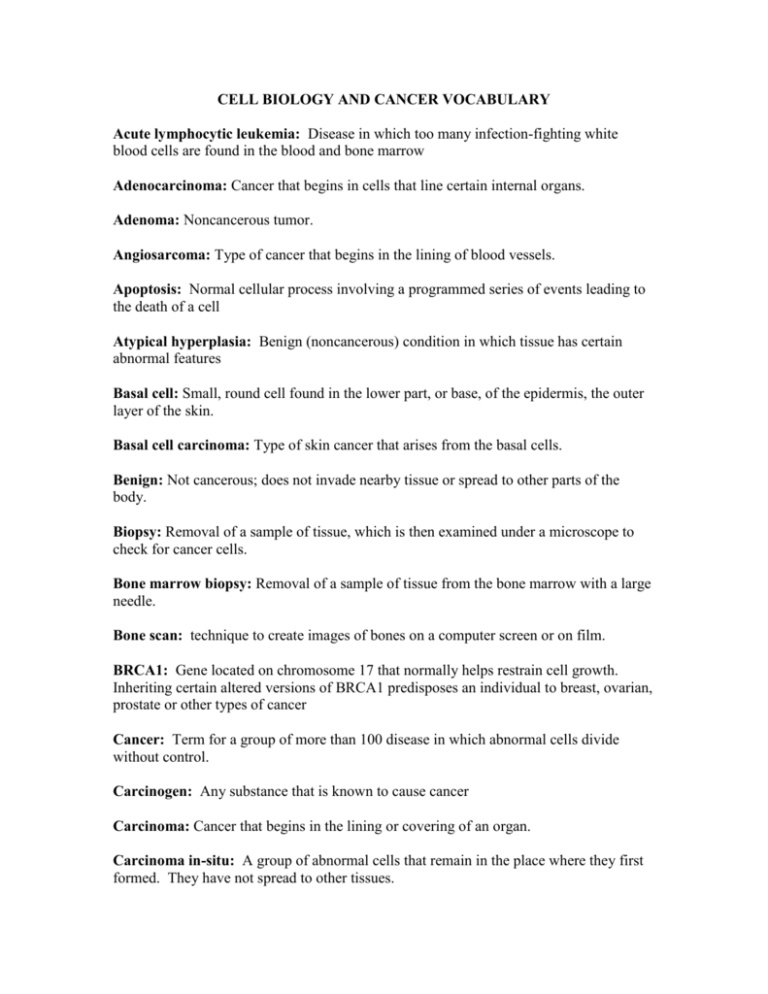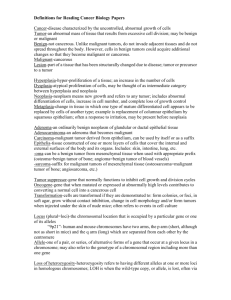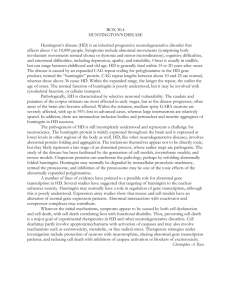acute lymphocytic leukemia: Type of blood cancer that originates in
advertisement

CELL BIOLOGY AND CANCER VOCABULARY Acute lymphocytic leukemia: Disease in which too many infection-fighting white blood cells are found in the blood and bone marrow Adenocarcinoma: Cancer that begins in cells that line certain internal organs. Adenoma: Noncancerous tumor. Angiosarcoma: Type of cancer that begins in the lining of blood vessels. Apoptosis: Normal cellular process involving a programmed series of events leading to the death of a cell Atypical hyperplasia: Benign (noncancerous) condition in which tissue has certain abnormal features Basal cell: Small, round cell found in the lower part, or base, of the epidermis, the outer layer of the skin. Basal cell carcinoma: Type of skin cancer that arises from the basal cells. Benign: Not cancerous; does not invade nearby tissue or spread to other parts of the body. Biopsy: Removal of a sample of tissue, which is then examined under a microscope to check for cancer cells. Bone marrow biopsy: Removal of a sample of tissue from the bone marrow with a large needle. Bone scan: technique to create images of bones on a computer screen or on film. BRCA1: Gene located on chromosome 17 that normally helps restrain cell growth. Inheriting certain altered versions of BRCA1 predisposes an individual to breast, ovarian, prostate or other types of cancer Cancer: Term for a group of more than 100 disease in which abnormal cells divide without control. Carcinogen: Any substance that is known to cause cancer Carcinoma: Cancer that begins in the lining or covering of an organ. Carcinoma in-situ: A group of abnormal cells that remain in the place where they first formed. They have not spread to other tissues. Chemotherapy: Treatment with anti-cancer drugs. Colonoscopy: Procedure that uses a flexible fiber optic endoscope to examine the internal surface of the colon along its entire length. Computed tomography: X-ray procedure that uses a computer to produce a detailed picture of a cross-section of the body; also called a CAT or CT scan. Death rate: Number of deaths per 100,000 people per year; also called mortality rate. Diagnosis: Process of identifying a disease by the signs and symptoms. Dysplasia: Abnormal cells that are not cancer. Encapsulated: Confined to a specific area; an encapsulated tumor remains in a compact form. Endometrial: Having to do with the endometrium, the layer of tissue that lines the uterus. Epidemiology: Study of the patterns, causes and control of disease in groups of people. Epidermis: Upper or outer layer of the two main layers of cells that make up the skin. Gene: The basic unit of heredity. Genetic: Inherited; having to do with information that is passed from parents to children through DNA in the genes. Grade: Describes how closely a cancer resembles normal tissue of its same type, along with the cancer’s probably rate of growth and tendency to spread. Grading: System for classifying cancer cells in terms of how malignant or aggressive they appear microscopically. The grading of a tumor indicates how quickly cancer cells are likely to spread and plays a role in treatment decisions. Human papilloma viruses: Viruses that generally cause warts. Some papillomaviruses are sexually transmitted. Some of these sexually transmitted viruses cause wartlike growths on the genitals, and some are thought to cause abnormal changes in cells of the cervix. Hyperplasia: Precancerous condition in which there is an increase in the number of normal cells in an organ or tissue. Incidence rate: Number of new cases per year per 100,000 people. In-situ cancer: Cancer that has remained within the tissue in which it originated. Invasive cancer: Cancer that has spread beyond the layer of tissue in which it developed. Leukemia: Cancer of the blood-forming tissue, such as the bone marrow, which causes large numbers of cells to be produced and enter the bloodstream. Malignant: Cancerous; can invade nearby tissue and spread to other parts of the body. Melanin: Skin pigment (substance that gives the skin its color). Dark-skinned people have more melanin than light-skinned people. Melanocyte: Cell in the skin and eyes that produces and contains the pigment called melanin. Melanoma: Cancer of the cells that produce pigment in the skin. Melanoma usually begins in a mole. Metastasis: The spread of cancer from one part of the body to another. Metastasize: To spread from one part of the body to another. When cancer cells metastasize and form secondary tumors, the cells in the metastatic tumor are like those in the original (primary) tumor. Mole: Area on the skin (usually dark in color) that contains a cluster of melanocytes. Mortality rate: The number of deaths per 100,000 per year. Necrosis: Cell death. Nevus: Medical term for a benign growth on the skin that is formed by a cluster of melanocytes, also called a mole. Oncogene: A gene that is a mutated form of a gene involved in normal cell growth. Oncologist: Doctor who specializes in treating cancer. Oncology: Study of cancer encompassing its physical, chemical and biologic properties. Polyp: Mass of tissue that projects into the colon. Prognosis: Probable outcome or course of a disease; the chance of recovery or recurrence. Proto-oncogene: A gene involved in normal cell growth. Mutations (changes) in a proto-oncogene may cause it to become an oncogene, which can cause the growth of cancer cells. Radiation therapy: Treatment with high-energy rays to kill cancer cells and shrink tumors. Remission: Decrease in or disappearance of the signs and symptoms of cancer. Retinoblastoma: Eye cancer caused by the loss of both copies of the tumor-suppressor gene RB; the inherited form typically occurs in childhood because one gene is missing from the time of birth. Retrovirus: A type of virus that has an RNA genome. The RNA acts as a template for the production of DNA that is integrated into the DNA of the host cell. Risk factor: Something that increase the chance of developing a cancer. Stage: Extent of a cancer, especially whether the disease has spread from the original site to other parts of the body. Staging: Doing exams and tests to learn the extent of the cancer, especially whether it has spread from its original site to other parts of the body. Stem cells: Cells from which all blood cells develop. SPF: Scale for rating the level of sunburn protection in sunscreens. Survival rate: Proportion of patients alive at some point (usually 5 years) after their initial diagnosis of cancer. Tumor: Abnormal mass of tissue that results from excessive cell division. Tumors perform no useful body function. They may be either benign (not cancerous) or malignant (cancerous). Tumor-suppressor gene: A type of gene that makes a protein called a tumor-suppressor protein that helps control cell growth. Ultraviolet radiation: Invisible rays that are part of the energy that comes from the sun. X-ray: High-energy radiation used in low doses to diagnose diseases and in high doses to treat cancer.









